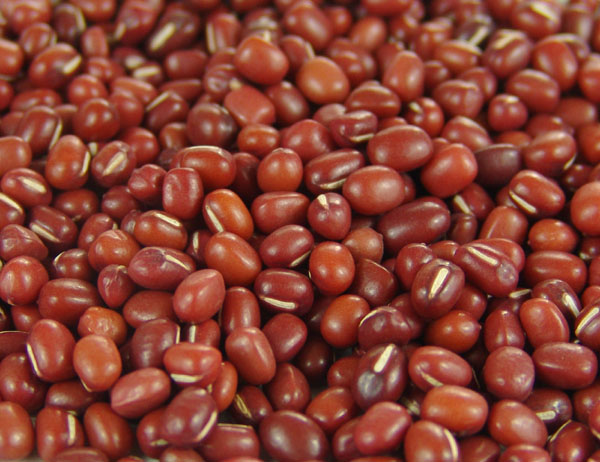This herb has a few other names, such aduki, azuki beans, and Vigna umbellata (Thunb.) Ohwi et Ohashi. In TCM's view, it refers to the seeds of Phaseolus calcaratus Roxb. or Phaseolus angularis Wight. Both of the plants are an annual vine in the family of Leguminosae. Adzuki bean is a type of small beans, which are compared to the large beans of soybean. There are three or four varieties of them, such as red bean (hongdou or chidou), white bean, and green bean (mung beans).
Dried adzuki bean is slightly cylindrical and flat, 5 to 7mm long, about 3mm in diameter, and with brown or purple-brown testa. It is smooth, hard, white, and slightly shiny. It also comes with a white linear hilum tilting to one side, which tends to sag into a longitudinal groove in the middle, about 2/3 of the whole length. And an inconspicuous ridge is usually found on the back. Two white seeds would show if the seed coat is removed. It has slight odor and beany flavor if chewing. The preferred one is with dried trunk, full grains, and in the color of dark crimson. In China, it is mainly found in provinces of Guangdong, Guangxi, and Jiangxi.
ADZUKI BEANS HEALTH BENEFITS
Traditional Chinese Medicine (TCM) believes that it is sweet, sour, and neutral in nature. It covers two meridians like heart and small intestine. Its main functions are to induce diuresis to alleviate edema and resolve toxin and expel pus. Its basic uses and indications are turgor and Edema, swollen limbs due to beriberi, jaundice induced dark urine, wind-damp pyretic arthralgia, sores, Carbuncles, Acute Appendicitis, and abdominal pain. Usual dosage is from 9 to 30 grams, in decoction normally.

Adzuki Beans
TYPICAL CHINESE HERBAL FORMULAS RELATED WITH ADZUKI BEANS
1) Ma Huang Lian Qiao Chi Xiao Dou Tang
This formula is from Shang Han Lun (On Cold Damage). It is formulated primarily for jaundice due to the accumulation of dampness and heat inside the body. Other major herbs include Ma Huang (Ephedrine), Lian Qiao (Forsythia), Xing Ren (Apricot Seed), zi bai pi (Cortex Caltalpae Ovatae), and so on.
2) Chi Xiao Dou Tang (adzuki bean soup)
This soup is from Sheng Ji Zong Lu (Complete Record of Holy Benevolence), and mainly designed for shortness of breath due to beriberi, difficult painful urination and bowel movement, swollen body, and foot swelling. Other prime herbs are Sang Bai Pi (Mulberry Root Bark), and Zi Su Ye (Perilla Leaf).
3) Chi Xiao Dou Dang Gui San
This prescription is selected from Jin Gui Yao Lue (Essential Prescriptions of the Golden Coffer). This is a formula used to clear heat and promoting diuresis as well as harmonizing Ying to relieve internal heat or fever. The other herb involved is Dang Gui (Chinese Angelica Root).

![Diseases, Symptoms, tcm, [tcmwindow.com]](/uploadFile/adImg/2015/11/11/f5cbfcc0-4df5-4646-9b9a-f316651a0199.jpg)





